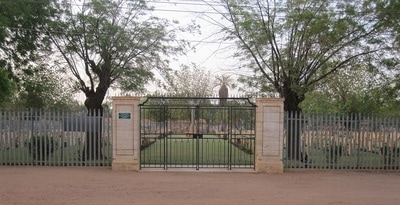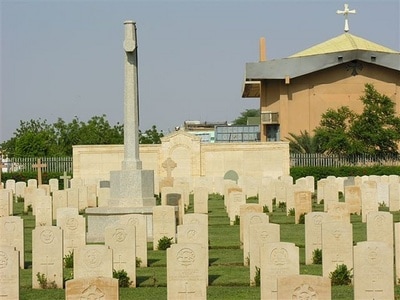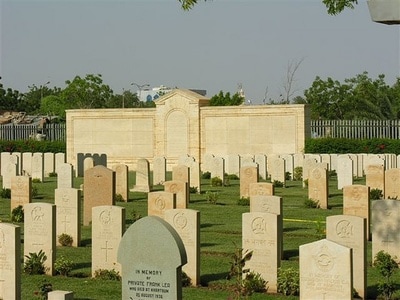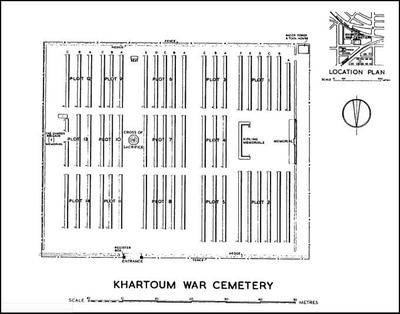KHARTOUM WAR CEMETERY AND KHARTOUM MEMORIAL
Khartoum
Sudan
Location Information
Khartoum War Cemetery lies on the south-eastern side of Khartoum, the capital of Sudan.
From Security Road, turn right into the unmade road adjacent to St Francis School and proceed for approximately 200 metres, past the entrance to Khartoum New Christian Cemetery, and the War Cemetery will be found on the left hand side.
Standing at the centre of the western boundary of the cemetery is the Khartoum Memorial which commemorates nearly 600 soldiers of the East African campaign of 1940-1941 who died in the Sudan, or in the advance into Eritrea and Northern Ethiopia, and who have no known grave.
Visiting Information
Cemetery opening hours:
Saturday to Thursday: 7.00am - 2.30pm
Friday: Closed
Wheelchair access is possible via the main entrance.
Historical Information
The cemetery is entered from the north through wrought-iron gates flanked by piers of Travertine. On the left-hand pier is a bronze register box. Sited axially on the entrance is the Cross of Sacrifice from which is glimpsed the Khartoum Memorial (covered in a separate Register).
On the eastern boundary of the cemetery is a memorial originally erected in Suakin Cemetery by the Brigade of Guards in honour of their comrades who fell in the 1885-1886 campaign. There are also 2 special memorials commemorating 16 soldiers of the Shropshire Regiment who died in 1885 and were buried in Suakin Cemetery but whose graves could not subsequently be located.
22 special memorial headstones commemorate United Kingdom soldiers who died prior to the 1914-1918 War and whose graves at Amadi, Wadi Halfa, Jubi and Suakin are now lost. 20 other special memorial headstones commemorate 10 East African soldiers buried at Juba Christian Cemetery, 5 East African and 1 South African soldier buried at Kosti Christian Cemetery, 2 East African and 1 United Kingdom soldier buried at Sennar Christian Cemetery and 1 Belgian soldier buried at El Obeid Christian Cemetery, whose graves are now lost.
Originally burials of both the 1914-1918 and 1939-1945 Wars were made in outlying parts of the Sudan, but in 1960 the graves were removed to the new war cemetery, for which the Sudan Government generously made available an additional piece of land adjoining the existing war graves plot in Khartoum. Other graves, including those of soldiers and civilians who died before and in between the two wars, were also concentrated into Khartoum War Cemetery from several burial places in the Sudan.
The cemetery was designed by Leslie D. Barrett and contains 73 Commonwealth commemorations of the 1914-1918 war and a further 322 of the 1939-1945 war. There are also over 400 Non World War commemorations.
Cemetery and Memorial pictures used with the permission of the Commonwealth War Graves Commission
Khartoum War Cemetery lies on the south-eastern side of Khartoum, the capital of Sudan.
From Security Road, turn right into the unmade road adjacent to St Francis School and proceed for approximately 200 metres, past the entrance to Khartoum New Christian Cemetery, and the War Cemetery will be found on the left hand side.
Standing at the centre of the western boundary of the cemetery is the Khartoum Memorial which commemorates nearly 600 soldiers of the East African campaign of 1940-1941 who died in the Sudan, or in the advance into Eritrea and Northern Ethiopia, and who have no known grave.
Visiting Information
Cemetery opening hours:
Saturday to Thursday: 7.00am - 2.30pm
Friday: Closed
Wheelchair access is possible via the main entrance.
Historical Information
The cemetery is entered from the north through wrought-iron gates flanked by piers of Travertine. On the left-hand pier is a bronze register box. Sited axially on the entrance is the Cross of Sacrifice from which is glimpsed the Khartoum Memorial (covered in a separate Register).
On the eastern boundary of the cemetery is a memorial originally erected in Suakin Cemetery by the Brigade of Guards in honour of their comrades who fell in the 1885-1886 campaign. There are also 2 special memorials commemorating 16 soldiers of the Shropshire Regiment who died in 1885 and were buried in Suakin Cemetery but whose graves could not subsequently be located.
22 special memorial headstones commemorate United Kingdom soldiers who died prior to the 1914-1918 War and whose graves at Amadi, Wadi Halfa, Jubi and Suakin are now lost. 20 other special memorial headstones commemorate 10 East African soldiers buried at Juba Christian Cemetery, 5 East African and 1 South African soldier buried at Kosti Christian Cemetery, 2 East African and 1 United Kingdom soldier buried at Sennar Christian Cemetery and 1 Belgian soldier buried at El Obeid Christian Cemetery, whose graves are now lost.
Originally burials of both the 1914-1918 and 1939-1945 Wars were made in outlying parts of the Sudan, but in 1960 the graves were removed to the new war cemetery, for which the Sudan Government generously made available an additional piece of land adjoining the existing war graves plot in Khartoum. Other graves, including those of soldiers and civilians who died before and in between the two wars, were also concentrated into Khartoum War Cemetery from several burial places in the Sudan.
The cemetery was designed by Leslie D. Barrett and contains 73 Commonwealth commemorations of the 1914-1918 war and a further 322 of the 1939-1945 war. There are also over 400 Non World War commemorations.
Cemetery and Memorial pictures used with the permission of the Commonwealth War Graves Commission








